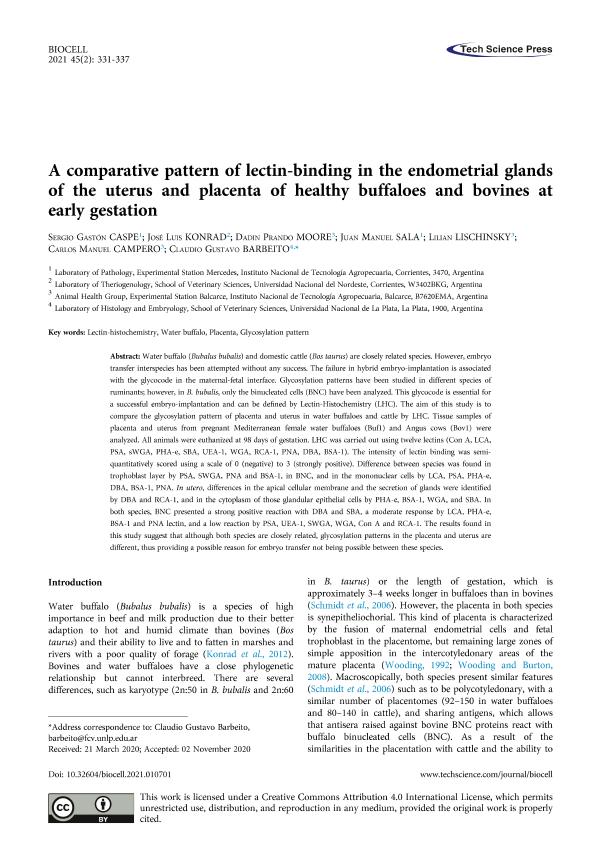Mostrar el registro sencillo del ítem
dc.contributor.author
Caspe, Sergio Gastón

dc.contributor.author
Konrad, José Luis

dc.contributor.author
Moore, Dadin Prando

dc.contributor.author
Sala, Juan Manuel

dc.contributor.author
Lischinsky, Lilian
dc.contributor.author
Campero, Carlos Manuel

dc.contributor.author
Barbeito, Claudio Gustavo

dc.date.available
2021-07-23T20:42:02Z
dc.date.issued
2021-02
dc.identifier.citation
Caspe, Sergio Gastón; Konrad, José Luis; Moore, Dadin Prando; Sala, Juan Manuel; Lischinsky, Lilian; et al.; A comparative pattern of lectin-binding in the endometrial glands of the uterus and placenta of healthy buffaloes and bovines at early gestation; Instituto de Histología y Embriología; Biocell; 45; 2; 2-2021; 331-337
dc.identifier.issn
0327-9545
dc.identifier.uri
http://hdl.handle.net/11336/136854
dc.description.abstract
Water buffalo (Bubalus bubalis) and domestic cattle (Bos taurus) are closely related species. However, embryo transfer interspecies has been attempted without any success. The failure in hybrid embryo-implantation is associated with the glycocode in the maternal-fetal interface. Glycosylation patterns have been studied in different species of ruminants; however, in B. bubalis, only the binucleated cells (BNC) have been analyzed. This glycocode is essential for a successful embryo-implantation and can be defined by Lectin-Histochemistry (LHC). The aim of this study is to compare the glycosylation pattern of placenta and uterus in water buffaloes and cattle by LHC. Tissue samples of placenta and uterus from pregnant Mediterranean female water buffaloes (Buf1) and Angus cows (Bov1) were analyzed. All animals were euthanized at 98 days of gestation. LHC was carried out using twelve lectins (Con A, LCA, PSA, sWGA, PHA-e, SBA, UEA-1, WGA, RCA-1, PNA, DBA, BSA-1). The intensity of lectin binding was semiquantitatively scored using a scale of 0 (negative) to 3 (strongly positive). Difference between species was found in trophoblast layer by PSA, SWGA, PNA and BSA-1, in BNC, and in the mononuclear cells by LCA, PSA, PHA-e, DBA, BSA-1, PNA. In utero, differences in the apical cellular membrane and the secretion of glands were identified by DBA and RCA-1, and in the cytoplasm of those glandular epithelial cells by PHA-e, BSA-1, WGA, and SBA. In both species, BNC presented a strong positive reaction with DBA and SBA, a moderate response by LCA, PHA-e, BSA-1 and PNA lectin, and a low reaction by PSA, UEA-1, SWGA, WGA, Con A and RCA-1. The results found in this study suggest that although both species are closely related, glycosylation patterns in the placenta and uterus are different, thus providing a possible reason for embryo transfer not being possible between these species.
dc.format
application/pdf
dc.language.iso
eng
dc.publisher
Instituto de Histología y Embriología

dc.rights
info:eu-repo/semantics/openAccess
dc.rights.uri
https://creativecommons.org/licenses/by/2.5/ar/
dc.subject
GLYCOSYLATION PATTERN
dc.subject
LECTIN-HISTOCHEMISTRY
dc.subject
PLACENTA
dc.subject
WATER BUFFALO
dc.subject.classification
Biología Reproductiva

dc.subject.classification
Ciencias Biológicas

dc.subject.classification
CIENCIAS NATURALES Y EXACTAS

dc.subject.classification
Otras Ciencias Veterinarias

dc.subject.classification
Ciencias Veterinarias

dc.subject.classification
CIENCIAS AGRÍCOLAS

dc.title
A comparative pattern of lectin-binding in the endometrial glands of the uterus and placenta of healthy buffaloes and bovines at early gestation
dc.type
info:eu-repo/semantics/article
dc.type
info:ar-repo/semantics/artículo
dc.type
info:eu-repo/semantics/publishedVersion
dc.date.updated
2021-07-19T18:44:49Z
dc.identifier.eissn
1667-5746
dc.journal.volume
45
dc.journal.number
2
dc.journal.pagination
331-337
dc.journal.pais
Argentina

dc.journal.ciudad
Mendoza
dc.description.fil
Fil: Caspe, Sergio Gastón. Instituto Nacional de Tecnologia Agropecuaria. Centro Regional Buenos Aires Norte. Estacion Experimental Agropecuaria Pergamino. Agencia de Extension Rural Mercedes.; Argentina
dc.description.fil
Fil: Konrad, José Luis. Consejo Nacional de Investigaciones Científicas y Técnicas. Centro Científico Tecnológico Conicet - Nordeste; Argentina. Universidad Nacional del Nordeste. Facultad de Cs.veterinarias. Departamento de Producción Animal; Argentina
dc.description.fil
Fil: Moore, Dadin Prando. Instituto Nacional de Tecnología Agropecuaria. Centro Regional Buenos Aires Sur. Estación Experimental Agropecuaria Balcarce. Agencia de Extensión Rural Balcarce; Argentina. Consejo Nacional de Investigaciones Científicas y Técnicas; Argentina
dc.description.fil
Fil: Sala, Juan Manuel. Instituto Nacional de Tecnologia Agropecuaria. Centro Regional Buenos Aires Norte. Estacion Experimental Agropecuaria Pergamino. Agencia de Extension Rural Mercedes.; Argentina
dc.description.fil
Fil: Lischinsky, Lilian. Instituto Nacional de Tecnología Agropecuaria. Centro Regional Buenos Aires Sur. Estación Experimental Agropecuaria Balcarce. Agencia de Extensión Rural Balcarce; Argentina
dc.description.fil
Fil: Campero, Carlos Manuel. Instituto Nacional de Tecnología Agropecuaria. Centro Regional Buenos Aires Sur. Estación Experimental Agropecuaria Balcarce. Agencia de Extensión Rural Balcarce; Argentina
dc.description.fil
Fil: Barbeito, Claudio Gustavo. Universidad Nacional de La Plata. Facultad de Ciencias Naturales y Museo. Cátedra de Histología y Embriología Animal; Argentina. Consejo Nacional de Investigaciones Científicas y Técnicas. Centro Científico Tecnológico Conicet - La Plata; Argentina
dc.journal.title
Biocell

dc.relation.alternativeid
info:eu-repo/semantics/altIdentifier/url/https://www.techscience.com/biocell/v45n2/41546
dc.relation.alternativeid
info:eu-repo/semantics/altIdentifier/doi/http://dx.doi.org/10.32604/biocell.2021.010701
Archivos asociados
